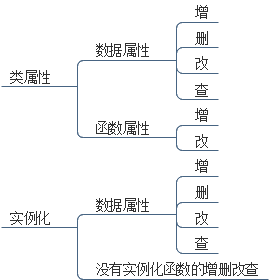一.类的组成
class Who(object):
what = 'what'
def __init__(self,name,age,gender):
self.name = name
self.age = age
self.gender =gender
def information(self):
print(self.name,self.age,self.gender)
p1 = Who('张三',18,'男')
p1.information()
1.1基本组成部分
- 由class定义
- 数据属性:由__init__()定义的部分
- 函数属性(方法属性):如上的def information(self)部分
- 实例化:p1 = Who('张三',18,'男')
- 实例化方法:p1.information()
- 其中的what是什么?【类属性】
1>类的属性字典:print(Who.__dicit__)
{'__module__': '__main__', 'what': 'what', '__init__': <function Who.__init__ at 0x00000132B95692F0>, 'information': <function Who.information at 0x00000132D04CAA60>, '__dict__': <attribute '__dict__' of 'Who' objects>, '__weakref__': <attribute '__weakref__' of 'Who' objects>, '__doc__': None}
从类的属性字典中,可以看出:数据属性和函数属性是以内存地址的方式存在的
2>实例化的属性字典:print(p1.__dict__)
{'name': '张三', 'age': 18, 'gender': '男'}
从实例化的属性字典中,可以看出:已经存储了具体的数据信息
3>实例化方法的实参传递
实例化调用类的方法函数:p1.information()
过程:实例化数据字典{'name': '张三', 'age': 18, 'gender': '男'}传递给类方法函数information(self)中的self;而self.name,self.age,self.gender实质上是在调用字典中的值 。
4>作用域问题:【类属性】
print(Who.what) #what
print(p1.what) #what
不论是实例化,还是类调用what变量,都能够取得对应的值。如同函数的作用于一样,在类的数据属性或实例化的数据属性中找不到what变量,就会到上一层去找。
1.2类数据的【增,删,改,查】
1.2.1数据【增】:Who.brother = 'jack'
{'__module__': '__main__', 'what': 'what', '__init__': <function Who.__init__ at 0x000001DFC85C92F0>, 'information': <function Who.information at 0x000001DFDF54AA60>, '__dict__': <attribute '__dict__' of 'Who' objects>, '__weakref__': <attribute '__weakref__' of 'Who' objects>, '__doc__': None, 'brother': 'jack'}
我们看到,增加的数据属性,增加到__init__的同一级而不是在其内,可以理解为what=‘what’一样的性质
同以下代码性质相同:
class Who(object):
what = 'what'
brother = 'jack'
def __init__(self,name,age,gender):
self.name = name
self.age = age
self.gender =gender
def information(self):
print(self.name,self.age,self.gender)
{'__module__': '__main__', 'what': 'what', 'brother': 'jack', '__init__': <function Who.__init__ at 0x000001BAA07792F0>, 'information': <function Who.information at 0x000001BAB76AAA60>, '__dict__': <attribute '__dict__' of 'Who' objects>, '__weakref__': <attribute '__weakref__' of 'Who' objects>, '__doc__': None}
1.2.2数据【删】:del Who.brother
1.2.3数据【改】:who.what = 'change'
1.2.4数据【查】:print(Who.what)
1.3函数的【增,改】
1.3.1增加类的方法函数:先定义一个函数,再增加
def sister(self): print(self.name,'is an only child of family') Who.sister = sister print(Who.__dict__)
{'__module__': '__main__', 'what': 'change', '__init__': <function Who.__init__ at 0x0000023683EE92F0>, 'information': <function Who.information at 0x000002369AE4AA60>, '__dict__': <attribute '__dict__' of 'Who' objects>, '__weakref__': <attribute '__weakref__' of 'Who' objects>, '__doc__': None, 'sister': <function sister at 0x0000023683B72EA0>}类的属性字典中增加了一个sister的方法函数
1.3.1更改类的方法函数:先定义一个函数,再更改
def brother(self): print(self.name,'have one little brother') Who.sister = brother print(Who.__dict__
更改前:{'__module__': '__main__', 'what': 'change', '__init__': <function Who.__init__ at 0x0000020BF10692F0>, 'information': <function Who.information at 0x0000020BFFFCAA60>, '__dict__': <attribute '__dict__' of 'Who' objects>, '__weakref__': <attribute '__weakref__' of 'Who' objects>, '__doc__': None, 'sister': <function sister at 0x0000020BEF1E2EA0>}
更改后: {'__module__': '__main__', 'what': 'change', '__init__': <function Who.__init__ at 0x0000020BF10692F0>, 'information': <function Who.information at 0x0000020BFFFCAA60>, '__dict__': <attribute '__dict__' of 'Who' objects>, '__weakref__': <attribute '__weakref__' of 'Who' objects>, '__doc__': None, 'sister': <function brother at 0x0000020BFFFCAAE8>}
这里我们发现,类的属性字典的key并没有变化,但是key(sister)对应的函数(地址)已经更改了。
1.4实例化的数据属性【增,删,改,查】【注意,这里没有实例化的函数的增删改查】
1.4.1实例化的数据属性【增】
p1.height = 173 print(p1.__dict__)
增加前:{'name': '张三', 'age': 18, 'gender': '男'}
增加后:{'name': '张三', 'age': 18, 'gender': '男', 'height': 173}
注意:这里仅仅增加了实例化的属性字典,而类的属性字典并没有发生变化
1.4.2实例化的数据属性【删】:del p1.height
1.4.3实例化的数据属性【改】:del p1.age = 21
1.4.4实例化的数据属性【查】:print(del p1.age)
总结:

注意:类属性字典中的数据属性和函数属性都是存储的内存地址
'__init__': <function Who.__init__ at 0x0000022E412A92F0>, 'information': <function Who.information at 0x0000022E581FAA60>
这里需要特别注意,下面的内容,与之相关。